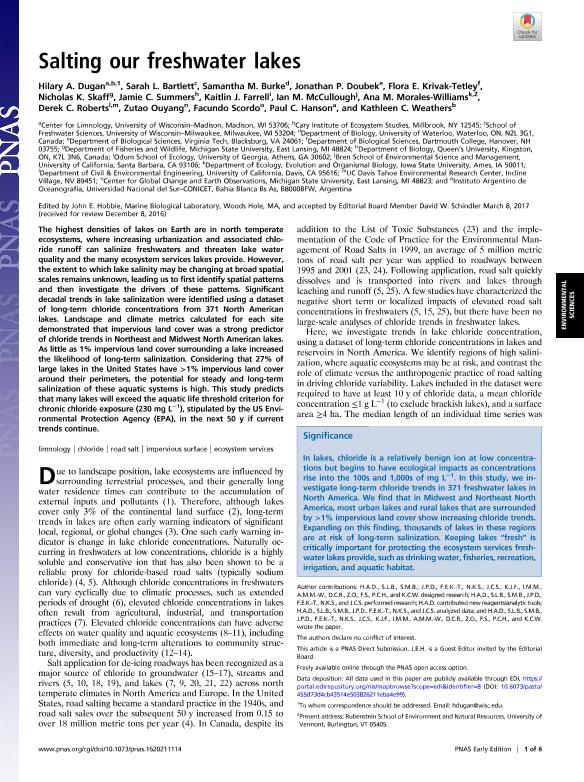Mostrar el registro sencillo del ítem
dc.contributor.author
Dugan, Hilary A.
dc.contributor.author
Bartlett, Sarah L.
dc.contributor.author
Burke, Samantha M.
dc.contributor.author
Doubek, Jonathan P.
dc.contributor.author
Krivak Tetley, Flora E.
dc.contributor.author
Skaff, Nicholas K.
dc.contributor.author
Summers, Jamie C.
dc.contributor.author
Farrell, Kaitlin J.
dc.contributor.author
McCullough, Ian M.
dc.contributor.author
Morales Williams, Ana M.
dc.contributor.author
Roberts, Derek C.
dc.contributor.author
Ouyang, Zutao
dc.contributor.author
Scordo, Facundo

dc.contributor.author
Hanson, Paul C.
dc.contributor.author
Weathers, Kathleen C.
dc.date.available
2017-11-03T14:35:52Z
dc.date.issued
2017-03
dc.identifier.citation
Dugan, Hilary A.; Bartlett, Sarah L.; Burke, Samantha M.; Doubek, Jonathan P.; Krivak Tetley, Flora E.; et al.; Salting our freshwater lakes; National Academy of Sciences; Proceedings of the National Academy of Sciences of The United States of America; 114; 17; 3-2017; 1-6
dc.identifier.issn
0027-8424
dc.identifier.uri
http://hdl.handle.net/11336/27529
dc.description.abstract
The highest densities of lakes on Earth are in north temperate ecosystems, where increasing urbanization and associated chloride runoff can salinize freshwaters and threaten lake water quality and the many ecosystem services lakes provide. However, the extent to which lake salinity may be changing at broad spatial scales remains unknown, leading us to first identify spatial patterns and then investigate the drivers of these patterns. Significant decadal trends in lake salinization were identified using a dataset of long-term chloride concentrations from 371 North American lakes. Landscape and climate metrics calculated for each site demonstrated that impervious land cover was a strong predictor of chloride trends in Northeast and Midwest North American lakes. As little as 1% impervious land cover surrounding a lake increased the likelihood of long-term salinization. Considering that 27% of large lakes in the United States have >1% impervious land cover around their perimeters, the potential for steady and long-term salinization of these aquatic systems is high. This study predicts that many lakes will exceed the aquatic life threshold criterion for chronic chloride exposure (230 mg L −1), stipulated by the US Environmental Protection Agency (EPA), in the next 50 y if current trends continue.
dc.format
application/pdf
dc.language.iso
eng
dc.publisher
National Academy of Sciences

dc.rights
info:eu-repo/semantics/openAccess
dc.rights.uri
https://creativecommons.org/licenses/by-nc-sa/2.5/ar/
dc.subject
Limnology
dc.subject
Chloride
dc.subject
Road Salt
dc.subject
Impervious Surface
dc.subject
Ecosystem Services
dc.subject.classification
Oceanografía, Hidrología, Recursos Hídricos

dc.subject.classification
Ciencias de la Tierra y relacionadas con el Medio Ambiente

dc.subject.classification
CIENCIAS NATURALES Y EXACTAS

dc.title
Salting our freshwater lakes
dc.type
info:eu-repo/semantics/article
dc.type
info:ar-repo/semantics/artículo
dc.type
info:eu-repo/semantics/publishedVersion
dc.date.updated
2017-10-12T19:33:54Z
dc.journal.volume
114
dc.journal.number
17
dc.journal.pagination
1-6
dc.journal.pais
Estados Unidos

dc.journal.ciudad
Washington
dc.description.fil
Fil: Dugan, Hilary A.. University of Wisconsin–Madison; Estados Unidos. Cary Institute of Ecosystem Studies; Estados Unidos. University of California at Davis; Estados Unidos
dc.description.fil
Fil: Bartlett, Sarah L.. University of Wisconsin–Milwaukee. School of Freshwater Sciences; Estados Unidos
dc.description.fil
Fil: Burke, Samantha M.. University of Waterloo. Department of Biology; Estados Unidos
dc.description.fil
Fil: Doubek, Jonathan P.. Virginia Tech. Department Of Biological Sciences; Estados Unidos
dc.description.fil
Fil: Krivak Tetley, Flora E.. Dartmouth College. Department Of Biological Sciences; Estados Unidos
dc.description.fil
Fil: Skaff, Nicholas K.. Michigan State University. Department Of Fisheries And Wildlife; Estados Unidos
dc.description.fil
Fil: Summers, Jamie C.. Queens University. Department Of Biology; Canadá
dc.description.fil
Fil: Farrell, Kaitlin J.. University Of Georgia. Odum School Of Ecology; Estados Unidos
dc.description.fil
Fil: McCullough, Ian M.. University of California. Bren School Of Environmental Science And Management; Estados Unidos
dc.description.fil
Fil: Morales Williams, Ana M.. Iowa State University. Department Of Ecology; Estados Unidos
dc.description.fil
Fil: Roberts, Derek C.. University of California at Davis; Estados Unidos. UC Davis Tahoe Environmental Research Center; Estados Unidos
dc.description.fil
Fil: Ouyang, Zutao. Michigan State University. Center for Global Change and Earth Observations; Estados Unidos
dc.description.fil
Fil: Scordo, Facundo. Consejo Nacional de Investigaciones Científicas y Técnicas. Centro Científico Tecnológico Conicet - Bahía Blanca. Instituto Argentino de Oceanografía. Universidad Nacional del Sur. Instituto Argentino de Oceanografía; Argentina
dc.description.fil
Fil: Hanson, Paul C.. University of Wisconsin–Madison. Center for Limnology; Estados Unidos
dc.description.fil
Fil: Weathers, Kathleen C.. Cary Institute of Ecosystem Studies; Estados Unidos
dc.journal.title
Proceedings of the National Academy of Sciences of The United States of America

dc.relation.alternativeid
info:eu-repo/semantics/altIdentifier/url/www.pnas.org/cgi/doi/10.1073/pnas.1620211114
dc.relation.alternativeid
info:eu-repo/semantics/altIdentifier/doi/http://dx.doi.org/10.1073/pnas.1620211114
Archivos asociados
